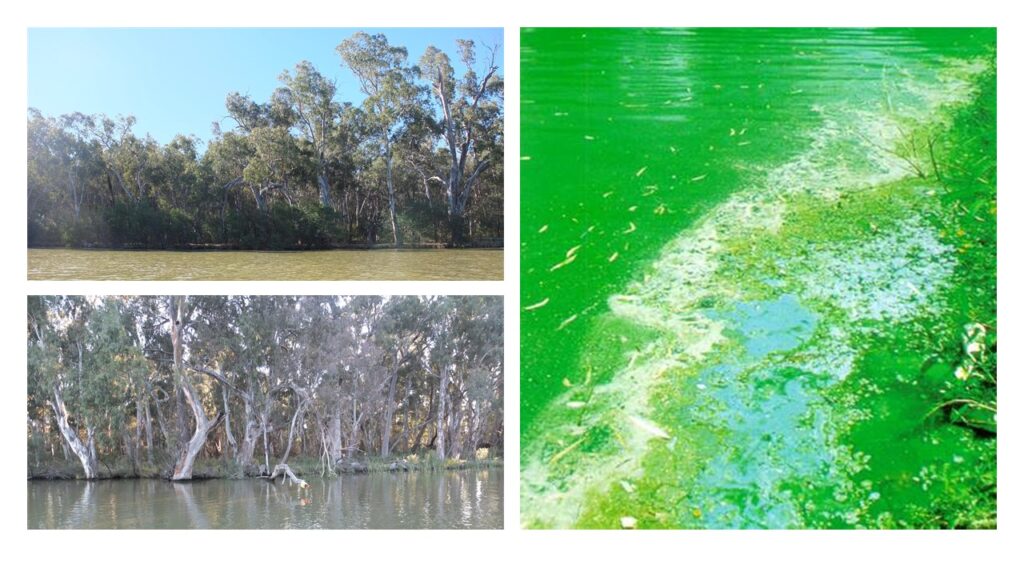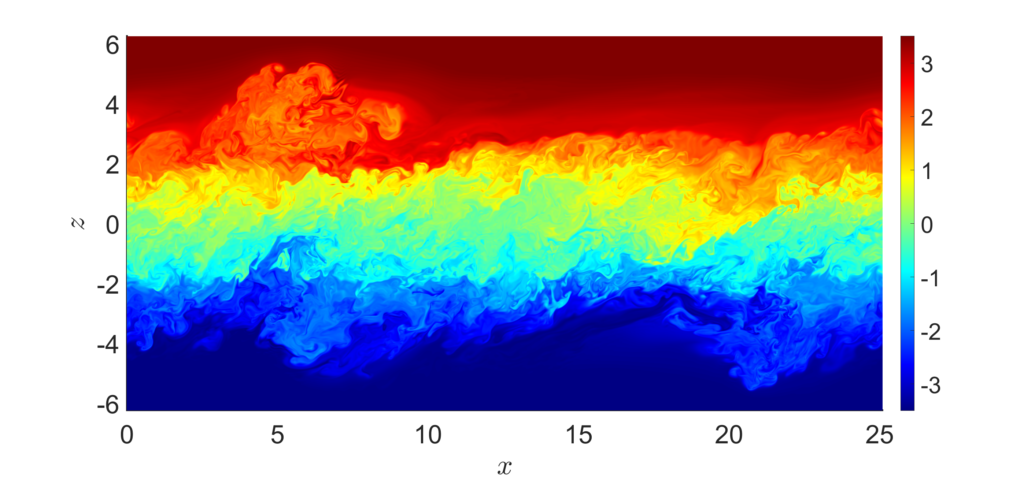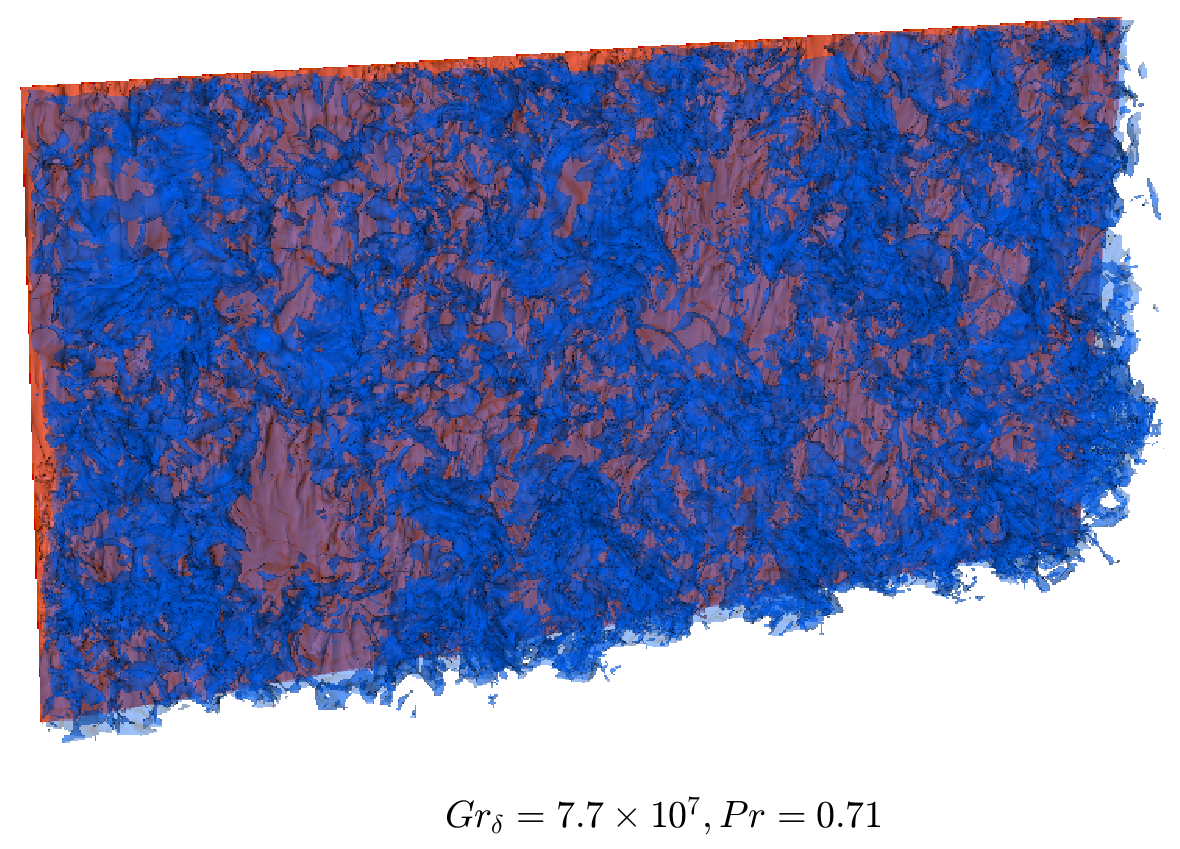We have a large research program in environmental fluid mechanics. This program covers both fundamental flows in stable and unstable configurations as well as modeling investigations of larger more complex flows. In this research, we typically involve some combination of numerical simulations, experiments, field measurements, and theoretical analysis.
Our main numerical approaches for environmental fluid mechanics projects are direct numerical simulation (DNS) and large eddy simulation (LES) using our in-house codes, SNS and PUFFIN. These simulations are run on massively parallel high-performance computing facilities, including the University’s HPC facility, Artemis, and the NCI facility, Gadi.
The Environmental Fluid Mechanics Laboratory has been developed to investigate complex turbulent mixing and exchange problems with a particular focus on stable/unstable density stratified environmental flows. The laboratory is fully equipped with PIV/LIF laser diagnostic tools, LDA and high sensitivity cameras. The laboratory has a number of large flumes developed to simulate at a laboratory scale, river flow, stably/unstably stratified boundary layers and negatively buoyant jets. These themes are ongoing interests for the group. The laboratory also supports the group’s field campaigns. We use high-fidelity instruments to take accurate high-resolution measurements of turbulent flow in-situ at locations such as the Murray River.
Lead Investigators: Assoc. Prof. Michael Kirkpatrick, Assoc. Prof. Nicholas Williamson, Prof. Steve Armfield
Research Fellows: Vassili Issaev
PhD Students: Shanil Jayawardena
Industry partner: The Murray Darling Basin Authority
Some of our current projects are listed below. We welcome applications to undertake a PhD on these projects.
Specific research projects advertised: #2328, #2329 #3426 All other inquiries are also welcome.
Rivers
Australia’s lowland rivers are particularly prone to thermal stratification due to our hot, dry, and sunny climate with its propensity for lengthy periods of drought. The resulting increase in flow stability inhibits turbulent mixing and leads to low levels of dissolved oxygen and the accumulation of contaminants. The changes to flow stability are also thought to be a contributing factor to the formation of blue-green algal blooms.
We have a comprehensive research program investigating both fundamentals of the flow conditions as well as an advanced modeling program.
The work is supported by the following recent ARC discovery project grants
- DP220100706 ‘Dynamics of suppressed mixing regimes in Australian rivers’
- DP150100912 ‘Thermal Stratification, Overturning and Mixing in Riverine Environments’
Selected Publications:
- Kirkpatrick, M., Williamson, N., Armfield, S., Zecevic, V. (2020). Destratification of thermally stratified turbulent open-channel flow by surface cooling. Journal of Fluid Mechanics, 829, A29-36
- Kirkpatrick, M., Williamson, N., Armfield, S., Zecevic, V. (2019). Evolution of thermally stratified turbulent open channel flow after removal of the heat source. Journal of Fluid Mechanics, 876, 356-412
- Williamson, N., Kirkpatrick, M., Armfield, S. (2018). Entrainment across a sheared density interface in a cavity flow. Journal of Fluid Mechanics, 835, 999-1021.
- Williamson, N., Kirkpatrick, M., Armfield, S., Norris, S. (2016). Convectively unstable turbulent open channel flow with stable surface stratification. ANZIAM Journal, 56, C246-C261
- Williamson, N., Armfield, S., Kirkpatrick, M., Norris, S. (2015). Transition to stably stratified states in open channel flow with radiative surface heating. Journal of Fluid Mechanics, 766, 528-555.

Fundamentals of turbulence in stratified flows
Rivers are large in scale and very turbulent. Under strongly stratified flow conditions however buoyancy can suppress mixing down to molecular levels. The relationship between the turbulent mixing and transport process and the background low conditions is poorly understood in these scenarios. The strongly stratified river flows which can occur in eastern Australia provide a unique opportunity to study these flow conditions. We use massive scale DNS, laboratory measurements and in-situ measurements to study these flows. A current focus of our research is the mixing processes that occur in the intermittent laminar-turbulent interface region that spontaneously forms in strongly stratified conditions.
Selected Publications:
- Issaev V, Williamson N, Armfield SW. Intermittency and critical mixing in internally heated stratified channel flow. Journal of Fluid Mechanics. 2023;963:A5. doi:10.1017/jfm.2023.303
- Issaev V, Williamson N, Armfield SW, Norris SE. Parameterization of mixing in stratified open channel flow. Journal of Fluid Mechanics. 2022;935:A17. doi:10.1017/jfm.2021.1159


Modeling riverine environments
Using numerical simulations, we are investigating the processes that can break down stable stratification including wind, night-time surface cooling, shear from the river bed, and circulation due to river bends. The aim here is to develop predictive tools that can be used to better manage Australia’s water resources.
The video on the right shows a simulation done using PUFFIN of mixing due to surface cooling in a thermally stratified river flow.
The upper panel shows temperature, while the lower panel shows vorticity.
The simulations are at a Reynolds number of Ret = 660, based on the friction velocity at the solid lower surface. This corresponds to a bulk Reynolds number of Reb = 15,000. The grid uses 1152 x 768 x 264 = 175 million grid cells, Computations were run in parallel on 288 cores of the Raijin supercomputer.
Direct numerical simulation of thermally stratified riverine flow subjected to surface cooling – temperature (upper) & vorticity fields (lower).
When do Algal blooms form?
Large-scale algal blooms occur regularly in inland Australian rivers. The formation of these blooms has been strongly associated with strongly stratified flow conditions. Our group aims to understand how these flow conditions contribute to the formation of algal blooms and provide advice to catchment managers on how these conditions can be avoided.
We have a large multi-disciplinary team and work collaboratively with field-based freshwater ecologists. We use numerical simulations of particle flow embedded within fully resolved river models to understand the interactions between turbulence and particle motion. We also have a field program where we directly measure turbulent flow conditions at the same time as measuring the spatial distribution of algae within the water column.
Convective Flows in the Environment
Volcanoes and plumes/jets in the atmosphere and oceans
Volcanic eruptions, plumes from urban heat islands and other atmospheric and ocean flows are all examples of free shear flows where buoyancy is a determining factor in flow behavior. Management and design of these processes requires the ability to accurately predict these flows and, in particular, entrainment and mixing with the ambient fluid. We examine the turbulent structure of fountains, plumes, and negatively buoyant jets using numerical simulation and laboratory experiments. See our Convective flows research for further details.

Dye visualisation image of a fountain
Melting ice sheets and ocean flows : Natural convection boundary layers at extreme scale
Understanding of fully turbulent regimes of natural convection boundary layers is critical to understanding large-scale environmental flows such as the melting of icebergs. State-of-the-art numerical methods are used to efficiently solve very large-scale turbulent flow simulations on >4000 CPUs. The images here show visualisations of flow in the turbulent regime. See our Convective flows research for further details.
